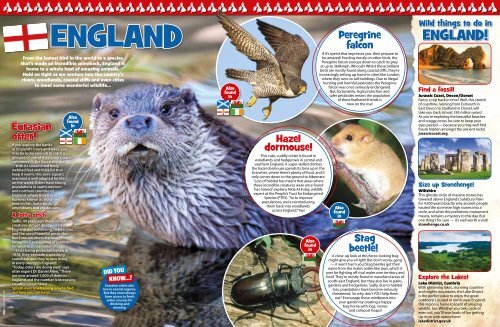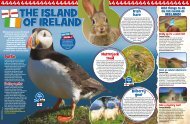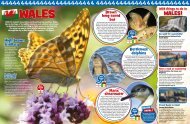88 NGKSUMM13england.v3
- No tags were found...
You also want an ePaper? Increase the reach of your titles
YUMPU automatically turns print PDFs into web optimized ePapers that Google loves.
Pictures © Getty Images UK.<br />
ENGLAND<br />
From the fastest bird in the world to a species<br />
that’s made an incredible comeback, England is<br />
home to a whole host of amazing animals.<br />
Hold on tight as we venture into the country’s<br />
rivers, woodlands, coastal cliffs and even cities<br />
to meet some wonderful wildlife...<br />
Also<br />
found<br />
in<br />
Eurasian<br />
otter!<br />
If you explore the banks<br />
of England’s rivers and lakes, you<br />
may be lucky enough to catch a<br />
glimpse of one of the nation’s super<br />
swimmers — the Eurasian otter!<br />
With its streamlined body,<br />
webbed feet and thick fur that<br />
keep it warm, this semi-aquatic<br />
mammal is well adapted for life<br />
on the water. Otters have strong<br />
populations in south-western<br />
and northern counties of<br />
England, where they live in<br />
burrows known as ‘holts’ and<br />
feed on fish, waterbirds,<br />
amphibians and crustaceans.<br />
A lotta otter<br />
Sadly, 40 years ago these incredible<br />
creatures almost disappeared in<br />
England due to hunting, habitat loss<br />
and the use of harmful pesticides.<br />
But Eurasian otters are now<br />
recognised as a symbol of success<br />
for wildlife conservationists.<br />
Since being protected by law in<br />
1978, they’ve made a splashing<br />
comeback and they’re now living<br />
in every county in England!<br />
“Today, otters are doing well,” says<br />
otter expert Dr Daniel Allen. “There<br />
are now around 1,600 of them in<br />
England and the number is increasing<br />
steadily.” Great news!<br />
Splash over to otter.org now to find<br />
out how you can help!<br />
DID YOU<br />
KNOW...?<br />
Eurasian otters also<br />
live in coastal regions.<br />
But they must always<br />
have access to fresh<br />
water sources for<br />
drinking and<br />
cleaning.<br />
Also<br />
found<br />
in<br />
Hazel<br />
dormouse!<br />
This cute, cuddly critter is found in<br />
woodlands and hedgerows in central and<br />
southern England. A super-skilled climber,<br />
the hazel dormouse spends its time up in the<br />
branches, where there’s plenty of food, and it<br />
only comes down to the ground to hibernate.<br />
“Loss of habitat has meant that areas where<br />
these incredible creatures were once found<br />
has halved,” explains Nida Al-Fulaij, wildlife<br />
expert at the People’s Trust for Endangered<br />
Species (PTES). “So to improve<br />
populations, we’re reintroducing<br />
them back into woodlands<br />
across England.” Yay!<br />
Peregrine<br />
falcon<br />
If it’s speed that impresses you, then prepare to<br />
be amazed! Feeding mostly on other birds, the<br />
Peregrine falcon swoops down to catch its prey<br />
at up to 360kmph. Whoosh! Whilst these brilliant<br />
birds are mostly found along coastal cliffs, they’re<br />
increasingly setting up home in cities like London,<br />
where they nest on tall buildings. Due to illegal<br />
hunting and harmful pesticides the Peregrine<br />
falcon was once seriously endangered.<br />
But, fortunately, legal protection and<br />
safer pesticides means the population<br />
of these feathered friends is<br />
now on the rise!<br />
Stag<br />
beetle!<br />
A close-up look at this fierce-looking bug<br />
might give you a fright! But don’t worry, gang<br />
— it won’t harm you! Stag beetles get their<br />
name from the male’s antler-like jaws, which it<br />
uses for fighting off rival males over territory and<br />
food. They’re mostly found in woodland areas of<br />
south-east England, but they also live in parks,<br />
gardens and hedgerows. Sadly, due to habitat<br />
loss, populations have become seriously<br />
threatened. So why don’t YOU help them<br />
out? Encourage these minibeasts into<br />
your garden by creating a happy<br />
bug home with logs, stones<br />
and compost heaps!<br />
Wild things to do in<br />
ENGLAND!<br />
Find a fossil!<br />
Jurassic Coast, Devon/Dorset<br />
Fancy a trip back in time? Well, this stretch<br />
of coastline, running from Exmouth in<br />
East Devon to Studland in Dorset, will<br />
take you back almost 185 million years!<br />
As you’re exploring the beautiful beaches<br />
and craggy coves, be sure to keep your<br />
eyes peeled — because you may well find<br />
fossils hidden amongst the ancient rocks!<br />
jurassiccoast.org<br />
Size up Stonehenge!<br />
Wiltshire<br />
This ghostly circle of massive stones has<br />
towered above England’s Salisbury Plain<br />
for 4,500 years! Exactly why ancient people<br />
hauled the six-metre high stones into a<br />
circle, and what this prehistoric monument<br />
means, remains a mystery to this day. But<br />
one thing’s for sure — it’s well worth a visit!<br />
stonehenge.co.uk<br />
Explore the Lakes!<br />
Lake District, Cumbria<br />
With glistening lakes, stunning coastline<br />
and mighty mountains, the Lake District<br />
is the perfect place to enjoy the great<br />
outdoors! Located in north-west England,<br />
this region is home to loads of amazing<br />
wildlife, too. Whether you trek, cycle or<br />
even sail, you’ll have loads of fun getting<br />
up close with nature here!<br />
lakedistrict.gov.uk<br />
18 National Geographic Kids<br />
ngkids.co.uk 19<br />
Also<br />
found<br />
in<br />
Also<br />
found<br />
in













